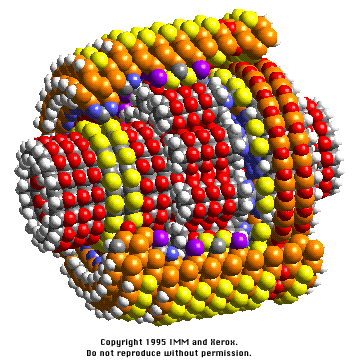A Molecular Planetary Gear


Many machines can be made in different sizes: very large or very small versions of the same basic design are possible. Many conventional designs can be scaled down to the molecular size range (if some care is taken in the design).
As an example, planetary gears convert shaft power from one angular frequency to another. The planetary gear shown here has not been built experimentally but has been modeled computationally. Other than its small size, it's rather unremarkable. In normal use, the shaft at the left would rotate at one frequency, while the planet carrier at the right would rotate at a lower frequency. The casing would be prevented from rotating by a larger framework (not shown).
The casing is a strained silicon shell with predominantly sulfur termination. Each of the nine planetery gears attaches to the planet carrier by a carbon-carbon single bond. The planet carrier itself is held in position by a bearing attached to the casing which prevents it from sliding out of position. Similarly, the input shaft on the left is held in position by a second bearing, also attached to the casing, which prevents it from sliding out of position. The planets themselves are geared both to the casing and the central sun gear. As the input shaft rotates the planets are driven around and around within the casing, causing the planet carrier to rotate with the planets.
This planetary gear was derived from the one illustrated on pages 311 and 312 of Nanosystems: Molecular Machinery, Manufacturing, and Computation by K. Eric Drexler. It was designed by Drexler of the Institute for Molecular Manufacturing and Ralph C. Merkle of Xerox PARC.
This page can be found on the WWW at
http://www.zyvex.com/nanotech/gearAndCasing.html.
A cross-eyed stereo pair is also available on the web.
Further technical information (including structure files)
is available.
Information on molecular manufacturing is available at
http://www.zyvex.com/nano.